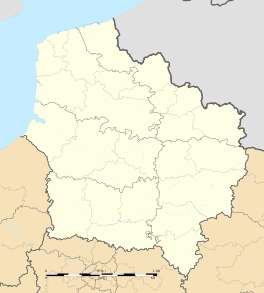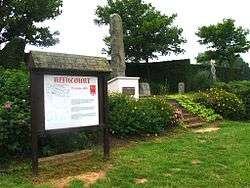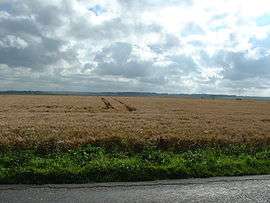Azincourt
| Azincourt | ||
|---|---|---|
|
Site of the battle of Agincourt | ||
| ||
 Azincourt | ||
|
Location within Hauts-de-France region  Azincourt | ||
| Coordinates: 50°28′N 2°08′E / 50.46°N 2.13°ECoordinates: 50°28′N 2°08′E / 50.46°N 2.13°E | ||
| Country | France | |
| Region | Hauts-de-France | |
| Department | Pas-de-Calais | |
| Arrondissement | Montreuil | |
| Canton | Le Parcq | |
| Intercommunality | 7 Vallées Comm | |
| Government | ||
| • Mayor (2014–) | Nicola Pocolet | |
| Area1 | 8.46 km2 (3.27 sq mi) | |
| Population (2009)2 | 302 | |
| • Density | 36/km2 (92/sq mi) | |
| Time zone | CET (UTC+1) | |
| • Summer (DST) | CEST (UTC+2) | |
| INSEE/Postal code | 62066 / 62310 | |
| Elevation | 100–142 m (328–466 ft) | |
|
1 French Land Register data, which excludes lakes, ponds, glaciers > 1 km² (0.386 sq mi or 247 acres) and river estuaries. 2 Population without double counting: residents of multiple communes (e.g., students and military personnel) only counted once. | ||
Azincourt (French pronunciation: [azɛ̃kuʁ]; historically, Agincourt /ˈæʒɪnkʊr/ in English) is a commune in the Pas-de-Calais department in northern France.
It is best known as the site of the Battle of Agincourt in 1415.
Geography
Situated 12 miles (19 kilometres) north-west of Saint-Pol-sur-Ternoise on the D71 road between Hesdin and Fruges
Etymology
The town's name is attested as Aisincurt in 1175, derived from a Germanic masculine name Aizo, Aizino and the early Northern French word curt 'farm with a courtyard' (Late Latin cortem). It has no etymological connection in French with Agincourt, Meurthe-et-Moselle (attested as Egincourt 875), which is derived from another Germanic male name *Ingin-.[1]
History
Azincourt is famous as being near the site of the battle fought on 25 October 1415 in which the army led by King Henry V of England defeated the forces led by Charles d'Albret on behalf of Charles VI of France, which has gone down in English history as the Battle of Agincourt. According to M. Forrest, the French knights were so encumbered by their armour that they were exhausted even before the start of the battle.[2]
Later on, when he became king in 1509, Henry VIII is supposed to have commissioned an English translation of a Life of Henry V[3] so that he could emulate him, on the grounds that he thought that launching a campaign against France would help him to impose himself on the European stage. In 1513, Henry VIII conclusively crossed the English Channel and stopped at Azincourt. He was notably accompanied by John Nevill.

The battle, as was the tradition, was named after a nearby castle called Azincourt. The castle has since disappeared and the settlement now known as Azincourt adopted the name in the seventeenth century.
Population
| Historical population | ||
|---|---|---|
| Year | Pop. | ±% |
| 1962 | 213 | — |
| 1968 | 220 | +3.3% |
| 1975 | 210 | −4.5% |
| 1982 | 228 | +8.6% |
| 1990 | 250 | +9.6% |
| 1999 | 276 | +10.4% |
| 2005 | 286 | +3.6% |
| 2009 | 302 | +5.6% |
Sights
The original battlefield museum in the village featured model knights made out of Action Man figures. However, this has now been replaced by the Centre Historique Medieval (CHM) a more professional museum, conference centre and exhibition space incorporating laser, video, slide shows, audio commentaries, and some interactive elements.[4] The museum building is shaped like a longbow similar to those used at the battle by archers under King Henry.
Since 2004 a large medieval festival organised by the local community, the CHM, The Azincourt Alliance,[5] and various other UK societies commemorating the battle, local history and medieval life, arts and crafts has been held in the village,[6] on a July. Prior to this date the festival was held in October, but due to the inclement weather and local heavy clay soil (like the battle) making the festival difficult it was moved to July. No festival will be held in 2014, with a number of events planned for 2015 on the 600th anniversary of the original battle.[7]

International relations
Twin towns/sister cities
Azincourt is twinned with:
See also
- Communes of the Pas-de-Calais department
- Agincourt, Ontario, Canada named for Azincourt, not Agincourt, Meurthe-et-Moselle
References
- ↑ Albert Dauzat and Charles Rostaing, Dictionnaire étymologique des noms de lieux en France, éditions Larousse 1968. p. 4.
- ↑ The House of Commons: 1509 – 1558, Volume 4; Stanley T. Bindoff, John S. Roskell, Lewis Namier, Romney Sedgwick, David Hayton, Eveline Cruickshanks, R. G. Thorne, P. W. Hasler (Boydell & Brewer, 1982)
- ↑ Henry VIII; J. J. Scarisbrick, p. 23
- ↑ Azincourt Centre Historique
- ↑ "Azincourt Alliance Home Page".
- ↑ "Videos from Azincourt" at Azincourt Alliance Archived 3 February 2014 at the Wayback Machine.
- ↑ "Azincourt 2015". Archived from the original on 10 August 2015.
- ↑ "British towns twinned with French towns [via WaybackMachine.com]". Archant Community Media Ltd. Archived from the original on 5 July 2013. Retrieved 20 July 2013.
External links
| Wikimedia Commons has media related to Azincourt. |
- Azincourt on the Quid website (French)

.svg.png)